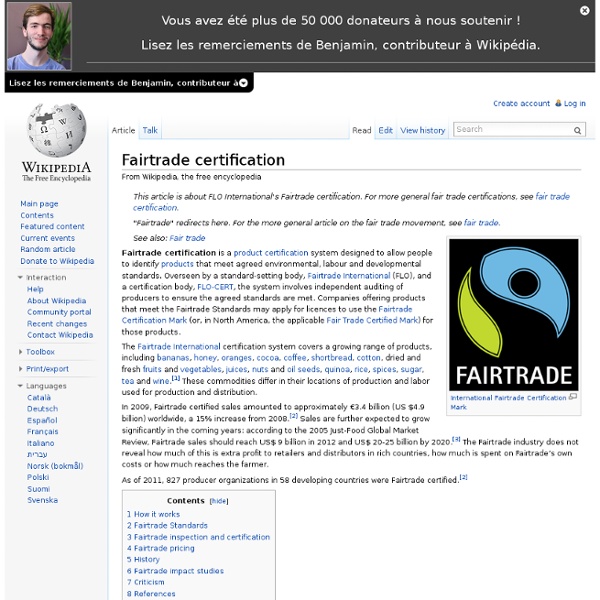Fair trade (disambiguation)
Fair trade is a consumer-driven movement to promote fair prices and reasonable conditions for producers of primary goods in developing regions. The expression may also denote:
About
Have Sustainability Labels lost their way?. In their bid to build a brand, Sustainability Labeling organizations are sacrificing their mission. More and more consumers want to know that an outside, independent party confirms that the claims made by brands are true, that the products are safe, good for the environment and deliver on some core promises. In a world where it has become almost impossible to consistently deceive consumers about the attributes of a product, and where exaggerated claims are quickly deconstructed and ridiculed in Facebook and Twitter, the rise of the sustainability label confirming product claims seems inevitable. Because the rise of third party certification and product labeling has happened gradually, it has seeped into the collective consciousness slowly, and now it is simply part of the shopping landscape in many consumer markets. According to the State of Sustainability Initiatives (SSI) 2014, growth has been spectacular. Case in point - cocoa Conclusion
Making Sense of Certification — Fair Trade, Direct Trade, Rainforest Alliance, UTZ, Whole Trade, and Organic. — Cooperative Coffees
Confused yet? Walk into your neighborhood café or pick up a pound of coffee from your local grocer and you’ll no doubt be overwhelmed by the number of different coffees available to you. You’ll need to choose your coffee from a variety of roasts, origins, and blends as well as decide which trade relations model you’d like to support. Which certificate to choose? Before you decide which type of certified or non-certified coffee to go with, you might ask yourself two questions: What do you want your dollar to do? With these two questions in mind, let’s take a look at our certification options. Fairtrade In a bean. According to Boston-based Equal Exchange, the United States largest and oldest fair trade company (1986), “Progressive church-based constituencies in Europe, linked to liberation theology-inspired cooperatives in southern Mexico drove the initial demand for Fair Trade/Organic coffee in the late 1980s.” So what does the Fairtrade Certificate guarantee? Read more about Fair Trade…
It's not fair to bash Fairtrade
Fairtrade is a controversial topic right now. A new study, conducted by the School of Oriental and African Studies at the University of London, found that poor agricultural workers in Uganda and Ethiopia have not benefited as much as they should from working on Fairtrade certified farms. These small-scale growers of coffee beans, flowers, and tea receive extremely low wages that are, in some cases, even lower than those of non-Fairtrade certified growers. “Wages in other comparable areas and among comparable employers producing the same crops but where there was no Fairtrade certification were usually higher and working conditions better. This study is getting significant attention because Fairtrade International is a high-profile organization that has been working for better labour rights since the late 1980s. To paint it in a bad light is a big deal. It’s important to keep in mind that Fairtrade works within a very complex world.
Fair trade
Fair trade is an organized social movement whose stated goal is to help producers in developing countries achieve better trading conditions and to promote sustainability. Members of the movement advocate the payment of higher prices to exporters, as well as higher social and environmental standards. The movement focuses in particular on exports from developing countries to developed countries, most notably handicrafts, coffee, cocoa, sugar, tea, bananas, honey, cotton, wine,[1] fresh fruit, chocolate, flowers, and gold.[2] The movement seeks to promote greater equity in international trading partnerships through dialogue, transparency and respect. It promotes sustainable development by offering better trading conditions to, and securing the rights of, marginalized producers and workers in developing countries.[3] There are several recognized Fairtrade certifiers, including Fairtrade International (formerly called FLO/Fairtrade Labelling Organizations International), IMO and Eco-Social.



